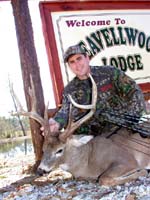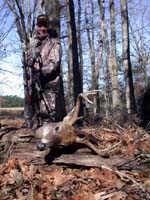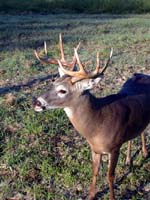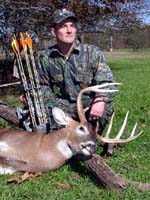
|
Features
|
|
|
|
Books
|
|
|
|
Fun & Games
|
|
|
|
Contact Us
|
|
|
John's Journal... Entry 219, Day 5
FIVE MOST CRITICAL INGREDIENTS TO BAGGING A DEER WITH A BOW
Hank Hearn
 Editor's
Note: Almost every bowhunter I know considers one of these five ingredients-the
wind, the availability of food, the rut, the weather and hunting pressure-as
the most-critical element of successful bow hunting. However, you really
must take into account all five factors if you plan to back a buck with
your bow. Here, five of the nation's most successful bowhunters pick the
ingredient they consider most important to their success and explain the
reasons for their selection. Hank Hearn, the former lodge manager of Willow
Point South, a part of Tara Wildlife located on the Mississippi-Louisiana
border near Vicksburg, Mississippi, avidly hunted deer and scouted for
deer on public lands before he began to manage the lodge. He learned how
to use hunting pressure to put deer in the places where he could take
them.
Editor's
Note: Almost every bowhunter I know considers one of these five ingredients-the
wind, the availability of food, the rut, the weather and hunting pressure-as
the most-critical element of successful bow hunting. However, you really
must take into account all five factors if you plan to back a buck with
your bow. Here, five of the nation's most successful bowhunters pick the
ingredient they consider most important to their success and explain the
reasons for their selection. Hank Hearn, the former lodge manager of Willow
Point South, a part of Tara Wildlife located on the Mississippi-Louisiana
border near Vicksburg, Mississippi, avidly hunted deer and scouted for
deer on public lands before he began to manage the lodge. He learned how
to use hunting pressure to put deer in the places where he could take
them.
 Where
I hunted in the Delta National Forest had several clear-cuts. My buddies
and I couldn't hunt in those clear-cuts because of the extremely-thick
brush. Instead, we hunted some soybean fields on the backside of the forest.
We could find deer coming to these fields during daylight hours almost
every day for the first week or two of deer season. Then the deer appeared
to become nocturnal and only feed on the beans at night. After hunting
these bean fields for two or three years, I realized the deer didn't bed
close to the bean fields where they fed. As I began to follow the deer
trails, I found the deer were actually bedding two or three miles away
from the bean fields. I started noticing the large amount of deer sign
as I walked through on my way to the bean fields. I decided instead of
going all the way to the back end of the property and hunting the bean
fields, I would hunt the trails closest to where I parked my car and farthest
away from the bean fields.
Where
I hunted in the Delta National Forest had several clear-cuts. My buddies
and I couldn't hunt in those clear-cuts because of the extremely-thick
brush. Instead, we hunted some soybean fields on the backside of the forest.
We could find deer coming to these fields during daylight hours almost
every day for the first week or two of deer season. Then the deer appeared
to become nocturnal and only feed on the beans at night. After hunting
these bean fields for two or three years, I realized the deer didn't bed
close to the bean fields where they fed. As I began to follow the deer
trails, I found the deer were actually bedding two or three miles away
from the bean fields. I started noticing the large amount of deer sign
as I walked through on my way to the bean fields. I decided instead of
going all the way to the back end of the property and hunting the bean
fields, I would hunt the trails closest to where I parked my car and farthest
away from the bean fields.
 For
several years, I consistently took more and bigger bucks than any of the
hunters who made the long hike back to the soybean fields. My friends
who went to the fields to hunt often walked past the deer they wanted
to take. The deer had learned where hunters entered the woods and where
they traveled to get back to the bean fields. They also knew if they stayed
in thick cover when the hunters entered the woods, the hunters would walk
away from them and back toward the bean fields. When I started hunting
the land everybody else walked away from, I began taking the bucks no
one else ever saw. The more pressure people put on a hunting area, the
further away from that hunting area the deer will bed and travel during
daylight hours.
For
several years, I consistently took more and bigger bucks than any of the
hunters who made the long hike back to the soybean fields. My friends
who went to the fields to hunt often walked past the deer they wanted
to take. The deer had learned where hunters entered the woods and where
they traveled to get back to the bean fields. They also knew if they stayed
in thick cover when the hunters entered the woods, the hunters would walk
away from them and back toward the bean fields. When I started hunting
the land everybody else walked away from, I began taking the bucks no
one else ever saw. The more pressure people put on a hunting area, the
further away from that hunting area the deer will bed and travel during
daylight hours.
 When
I realized what effect hunting pressure had on deer and how I could use
hunting pressure to put deer where I wanted to hunt them, I applied this
strategy to public lands to move deer toward my hunters at Willow Point
when I was there. For this method to work, you have to study the land
you hunt for several years. I had to learn where deer moved to once hunting
pressure forced them out of a particular area. By knowing where deer moved
when forced out of an region by hunting pressure, I could put my tree
stands in the sites where deer would go before they actually starting
using those places. While at Tara, I even would build up hunting pressure
in one site to force bucks to move where I already had tree stands set
up for the next time that I wanted to hunt. A smart bowhunter will learn
how to use hunting pressure to put bucks in front of his stand.
When
I realized what effect hunting pressure had on deer and how I could use
hunting pressure to put deer where I wanted to hunt them, I applied this
strategy to public lands to move deer toward my hunters at Willow Point
when I was there. For this method to work, you have to study the land
you hunt for several years. I had to learn where deer moved to once hunting
pressure forced them out of a particular area. By knowing where deer moved
when forced out of an region by hunting pressure, I could put my tree
stands in the sites where deer would go before they actually starting
using those places. While at Tara, I even would build up hunting pressure
in one site to force bucks to move where I already had tree stands set
up for the next time that I wanted to hunt. A smart bowhunter will learn
how to use hunting pressure to put bucks in front of his stand.
To learn more about master deer hunters, click here for John Phillip's deer-hunting books.
Check back each day this week for more about FIVE MOST CRITICAL INGREDIENTS TO BAGGING A DEER WITH A BOW ...
Day 1 - Brad Harris
Day 2 - Ray McIntyre
Day 3 - Will Primos
Day 4 - Mark Drury
Day 5 - Hank Hearn